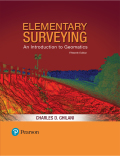
Concept explainers
In adjusting measured traverse angles‘ why aren’t adjustments made in proportion to the angle sizes?
The reason why the adjustments are not made in proportion to the angle sizes in adjusting measured traverse angles.
Answer to Problem 10.1P
Error is independent of angle size and depends on the method used for measurement.
Explanation of Solution
In elementary methods of traverse adjustment, the first step is to balance the angles to the proper geometric total. For a closed traverse angle balancing is easy since the total error is known. Angles of the closed traverse can be adjusted to the total geometry by any of the following methods:
- Applying an average correction to each angle of the traverse.
- Making larger corrections where the observations and measurements are not done properly.
In a closed traverse, if a single angle is not measured accurately then, error occurring due to one observation reflects in other observations. It is independent on the size of the angle and depends on the method used while measuring the angles. Therefore, adjustments are not made in proportion to the angle sizes in measured traverse angles.
Want to see more full solutions like this?
Chapter 10 Solutions
EBK ELEMENTARY SURVEYING
Additional Engineering Textbook Solutions
Starting Out with Programming Logic and Design (5th Edition) (What's New in Computer Science)
Concepts Of Programming Languages
Starting Out With Visual Basic (8th Edition)
Starting Out with Java: From Control Structures through Objects (7th Edition) (What's New in Computer Science)
Thinking Like an Engineer: An Active Learning Approach (4th Edition)
Mechanics of Materials (10th Edition)
- Computation must be completeFor the given cantilever beam shown in the figure below,a. Draw the shear and moment diagram using service loads.b. Determine the critical design moment using Working Stress Design (Ma) load combinations.c. Draw the shear and moment diagram using factored loads.d. Determine the critical design moment using Strength Design (Mu) load combinations, use NSCP2015.e. For the given cross-section of the beam, give the reason why the reinforcement is at the topportion of the beam section?arrow_forwardLAB: FORCE AND FORCE-RELATED VARIABLES ASSIGNMENT INSTRUCTIONS INSTRUCTIONS Lab assignments are intended to give you some ‘hands on' experience in applying the concepts introduced in the course text. They are designed to get you out of your classroom or office and develop the skills of designing experiments and collecting data, and then performing calculations, evaluating the results, and communicating your findings. Labs are more than just number crunching - they are about reflecting on what is both practical and technically sound engineering problem-solving. For each problem below, address the scenario presented and develop engineering solutions. Communicate your results using drawings, pictures, and discussion, supported by calculations developed using the Microsoft Equation Editor or similar tool. Submit your lab report in a single pdf file uploaded to the location provided in Canvas before the due date/time indicated. Each problem should be treated as a micro-report with a problem…arrow_forwardHow can a construction estimator gain experience to better judge appropriate contingency amounts?arrow_forward
- What are the potential risks and rewards of including a higher or lower contingency amount in a construction estimate?arrow_forwardDraw moment and shear diagramsarrow_forwardFIND THE INTERNAL MISSING ANGLES AND MISSING SIDESOF A 90° RIGHT TRIANGLE WITH A HEIGHT OF 96 AND A BASE OF 48.DRAW A PROPORTIONAL SKETCH OF THE TRIANGLE, IDENTIFY GIVEN INFORMATIONAND LABEL MISSING INFORMATION. WHAT IS AREA TO THE NEAREST SQ. FT.?arrow_forward
 Architectural Drafting and Design (MindTap Course...Civil EngineeringISBN:9781285165738Author:Alan Jefferis, David A. Madsen, David P. MadsenPublisher:Cengage Learning
Architectural Drafting and Design (MindTap Course...Civil EngineeringISBN:9781285165738Author:Alan Jefferis, David A. Madsen, David P. MadsenPublisher:Cengage Learning Traffic and Highway EngineeringCivil EngineeringISBN:9781305156241Author:Garber, Nicholas J.Publisher:Cengage Learning
Traffic and Highway EngineeringCivil EngineeringISBN:9781305156241Author:Garber, Nicholas J.Publisher:Cengage Learning Engineering Fundamentals: An Introduction to Engi...Civil EngineeringISBN:9781305084766Author:Saeed MoaveniPublisher:Cengage Learning
Engineering Fundamentals: An Introduction to Engi...Civil EngineeringISBN:9781305084766Author:Saeed MoaveniPublisher:Cengage Learning Materials Science And Engineering PropertiesCivil EngineeringISBN:9781111988609Author:Charles GilmorePublisher:Cengage Learning
Materials Science And Engineering PropertiesCivil EngineeringISBN:9781111988609Author:Charles GilmorePublisher:Cengage Learning Construction Materials, Methods and Techniques (M...Civil EngineeringISBN:9781305086272Author:William P. Spence, Eva KultermannPublisher:Cengage Learning
Construction Materials, Methods and Techniques (M...Civil EngineeringISBN:9781305086272Author:William P. Spence, Eva KultermannPublisher:Cengage Learning Residential Construction Academy: House Wiring (M...Civil EngineeringISBN:9781285852225Author:Gregory W FletcherPublisher:Cengage Learning
Residential Construction Academy: House Wiring (M...Civil EngineeringISBN:9781285852225Author:Gregory W FletcherPublisher:Cengage Learning





